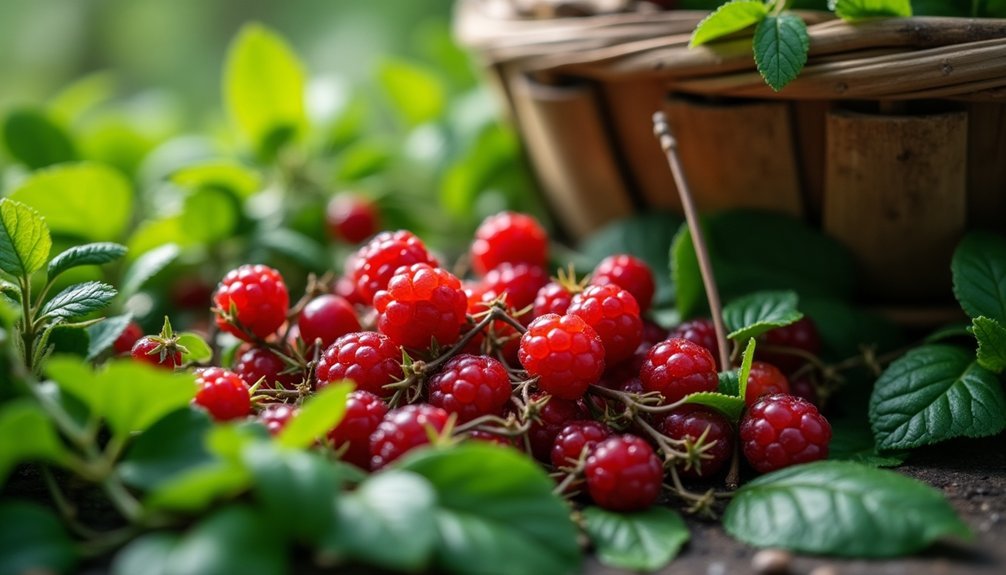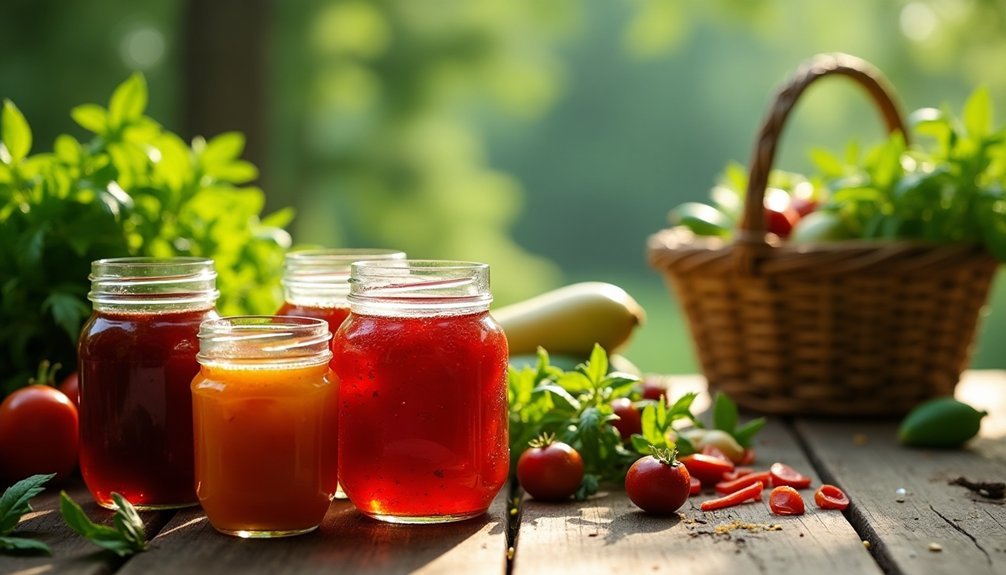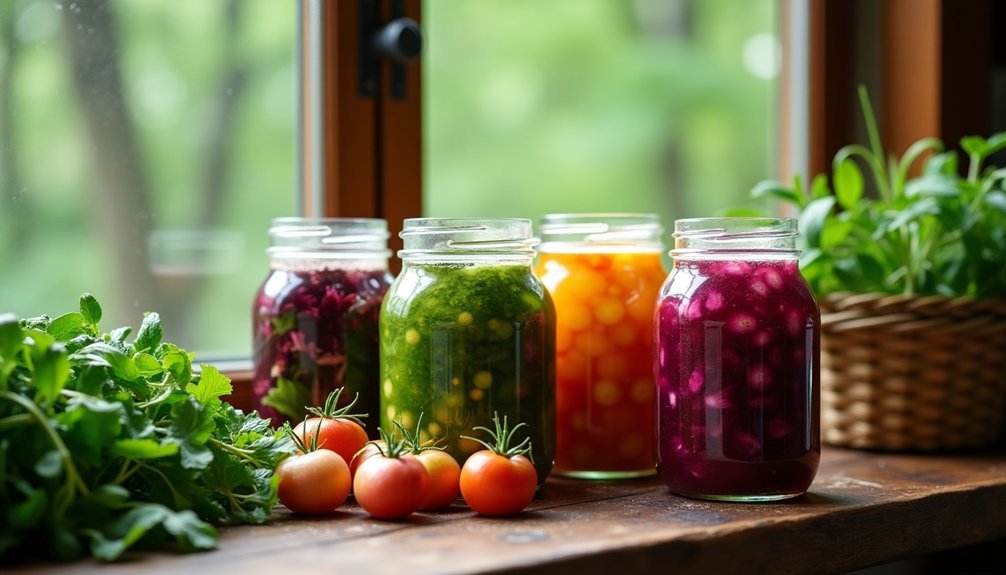Discover nature's pantry hiding in plain sight with these seven forest-to-kitchen preservation methods. You'll learn to identify edible urban plants, transform invasive species into delicious staples, join neighborhood canning circles, create seasonal dehydrating schedules, harness wild fermentation, harvest ethically from street trees, and participate in preservation swap meets. These sustainable practices not only reduce your grocery bills but also connect you with your local ecosystem and community. The forest's bounty awaits your kitchen's creativity.
Hidden Edibles in Urban Parks: What to Forage and How to Preserve

Did you know that your local urban park might be a treasure trove of free, nutritious food? From native berries like elderberry and chokeberry to common herbs and nuts, urban landscapes offer surprising edible options.
Urban foraging reveals the secret garden in plain sight—nature's pantry waiting just beyond your doorstep.
When foraging, proper identification is essential—use reliable guidebooks or plant identification apps to guarantee safety. Harvest sustainably by taking only what you need and leaving plenty behind for wildlife and regrowth.
Once you've collected your urban bounty, preserve it to enjoy year-round. Try drying herbs for teas, freezing berries for smoothies, or making jam from fruit harvests. Some parks, like Zonolite Park, have been transformed with edible native plants that offer abundant foraging opportunities.
Pickling wild garlic adds flavor to winter meals, while infusing dandelion in oil creates unique dressings. These preservation methods not only extend your harvest but also connect you to seasonal eating cycles.
Transforming Invasive Species Into Pantry Staples
While urban parks offer familiar forageable foods, another untapped resource lies right under our noses: invasive species. You'll find nutritional powerhouses like garlic mustard, Japanese knotweed, and autumn olive that can become delicious pantry staples.
Transform these plants into preserves, pickles, and seasonings using simple techniques like canning and dehydration. Garlic mustard makes exceptional pesto that freezes beautifully, while autumn olive berries create vibrant jams rich in antioxidants. Japanese knotweed's tart stems can be pickled like rhubarb.
Before harvesting, check local regulations and verify plants haven't been treated with pesticides. Proper disposal of unused plant material is vital to prevent further spread. Remember to always harvest invasive plants before they produce seeds to avoid unwanted dispersal during collection and processing.
The Neighborhood Canning Circle: Building Community Through Preservation

When neighbors gather around steaming pots and clicking jar lids, they're doing more than preserving the season's bounty—they're cultivating community resilience.
These canning circles create accessible spaces where diverse community members collaborate, building stronger social bonds through shared preservation efforts.
You'll find economic benefits too. By participating, you're supporting local farmers while gaining year-round access to nutritious food without refrigeration costs. Historically, this approach empowered farming families to avoid selling during price gluts, increasing their income and food security.
The environmental impact is equally impressive—you'll reduce food waste, minimize packaging, and lower transportation emissions through local sourcing.
Community canneries offer valuable skill development in food safety and preservation techniques.
The shared equipment makes this practice accessible to everyone, transforming ordinary spaces into vibrant resource hubs where people connect, learn, and sustain traditions that nurture both community and environment.
Seasonal Dehydrating Calendar for Your Local Ecosystem
Harmony between your preservation practices and the natural world begins with a seasonal dehydrating calendar tailored to your local ecosystem.
As climate patterns shift, you'll need to adapt traditional timing methods and incorporate Indigenous ecological knowledge to guarantee superior preservation results.
- Watch natural indicators – Notice phenological events like specific flower blooms or bird migrations that signal prime harvesting windows.
- Track daylight patterns – Adjust your dehydrating schedule based on changing day lengths that affect both plant growth and drying conditions.
- Monitor local weather cycles – Document precipitation patterns and temperature fluctuations to predict ideal drying periods.
- Engage with community knowledge – Participate in workshops where intergenerational wisdom about local ecosystems is shared, enhancing your preservation techniques.
Wild Fermenting: Urban Microbiomes in Your Kitchen

You'll find powerful microbial allies for fermentation right in your urban environment, from wild-harvested starters on fruit peels to naturally occurring bacteria on organic vegetables.
When working with these living cultures, you must sterilize all equipment, maintain proper salinity in brines, and keep fermenting foods fully submerged to prevent harmful contamination.
Your kitchen transforms into a laboratory of beneficial microorganisms that can safely preserve foods for months while enhancing their nutritional profile and developing complex flavor compounds. The active fermentation process creates lactobacillus bacteria that produce new vitamins and enzymes that improve food digestibility.
Urban Foraging Fermentation Basics
Urban environments offer surprising opportunities for combining wild food foraging with fermentation techniques, creating a unique approach to preservation that harnesses your local microbiome.
Before diving in, verify you've properly identified and thoroughly cleaned your foraged finds to remove pollutants and contaminants.
For successful urban foraging fermentation:
- Prepare properly – Use non-iodized salt (kosher or sea salt) at 2-4% by weight for ideal fermentation conditions.
- Control your environment – Maintain 68-72°F initially, then store in cooler temperatures once fermentation is complete.
- Use proper equipment – Select appropriate vessels like Mason jars with weights to keep ingredients submerged.
- Create anaerobic conditions – Confirm food remains under brine to promote beneficial bacteria growth while preventing spoilage. This environment supports the anaerobic respiration process essential to successful fermentation.
Microbe-Rich Wild Starters
Diving into the world of wild fermentation reveals how microbial communities right in your neighborhood can transform ordinary ingredients into extraordinary preserved foods.
Your kitchen already hosts unique microbial populations that can jumpstart fermentation without commercial starters.
Lactobacillus bacteria naturally present on fresh vegetables do the heavy lifting when you create the right environment. By controlling salt levels and ensuring an oxygen-free setting, you'll cultivate beneficial microbes while inhibiting unwanted ones.
The beauty of wild fermentation lies in its reflection of your local environment—each batch captures your neighborhood's microbial signature.
You'll not only create distinctive flavors but also support gut health through diverse probiotics.
Start simple with cabbage or vegetables, then customize with spices and herbs to develop your own microbe-rich wild starters. According to experts like Sandor Katz, fermentation is particularly welcoming for beginners because of the resilience of communities that can bounce back even after periods of neglect.
Fermenting Safety Protocols
While harnessing wild microbes opens up exciting culinary possibilities, following proper safety protocols guarantees your fermentation experiments remain both delicious and safe.
Successful fermentation requires maintaining the right environment for beneficial bacteria to thrive while preventing harmful pathogens.
- Clean thoroughly – Wash all equipment, surfaces, and your hands with soap and potable water before starting your fermentation project.
- Monitor acidity – Use pH strips to verify your ferment maintains a pH below 4.6, creating an environment too acidic for dangerous bacteria like C. botulinum.
- Control temperature – Keep ferments between 60-75°F for vegetables to ensure proper microbial activity and prevent spoilage.
- Check regularly – Inspect your ferments daily for off-odors, unusual colors, or mold growth, and monitor pH levels throughout the process.
Most fermentations involve converting sugars into products like acids or alcohols that both preserve nutrients and inhibit spoilage microbes, a process discovered millennia ago.
From Street Trees to Preserved Delights: Ethical Urban Harvesting
As city dwellers walk past fruit-laden branches overhanging sidewalks, they're often unaware of the bountiful harvesting opportunities right above their heads. You can ethically harvest from urban trees by checking local regulations and selecting healthy specimens. Sustainable urban harvesting methods mirror the selective harvesting practices used in responsible forest management.
| Urban Harvest Type | Preservation Method |
|---|---|
| Crabapples | Jellies & Chutneys |
| Serviceberries | Drying & Freezing |
| Mulberries | Jams & Syrups |
| Chestnuts | Roasting & Canning |
Community harvesting events build neighborhood connections while reducing food waste. Before collecting, verify you're not damaging trees or ecosystems. Many cities offer workshops on identifying edible urban fruits and proper harvesting techniques. By participating in urban harvesting, you're supporting biodiversity, reducing carbon footprints, and connecting with traditional food preservation methods.
Preservation Swap Meets: Exchange Your Forest Finds With Neighbors
Beyond the urban fruit trees lies another opportunity for sustainable food enthusiasts—forest-to-kitchen preservation swap meets.
These community gatherings allow you to trade your foraged berries, mushrooms, and other forest finds while learning preservation techniques from neighbors.
You'll discover benefits that extend far beyond your pantry:
- Knowledge exchange – Learn canning, fermenting, and dehydrating methods from experienced foragers
- Access to variety – Trade your blackberries for someone's pickled mushrooms
- Cost savings – Reduce grocery bills by sharing nature's abundance
- Community building – Connect with like-minded neighbors passionate about sustainable living
Many participants bring vacuum-sealed foods that maintain quality for longer periods, making them excellent trading items at these events.
Despite challenges like regulatory compliance and quality control, these swap meets are evolving with technology integration and educational workshops to make preservation knowledge more accessible.
Frequently Asked Questions
Is Permission Required to Harvest From Public Forests or Parks?
Yes, you'll typically need permits for National Forests ($20+ annually), with specific limits like 1 gallon per day for berries. State parks often prohibit foraging entirely. Always check local regulations before harvesting from public lands.
Can Children Safely Participate in Foraging and Preservation Activities?
Yes, children can safely participate in foraging when supervised by knowledgeable adults. You'll want to teach them proper plant identification, never taste without confirmation, and assign age-appropriate preservation tasks like drying fruits or making jam.
How Do You Identify Potentially Toxic Look-Alike Plants?
You'll need to study leaf patterns, plant structures, and habitats carefully. Look for specific identifiers like leaf arrangement, stems, and berries. When in doubt, consult field guides or experts before touching unknown plants.
Are Preservation Techniques Different for Medicinal Versus Culinary Plants?
Yes, preservation techniques differ. While you'll use drying, freezing, and vacuum sealing for both, medicinal plants need more careful handling, controlled temperature, and limited light exposure to maintain their potency and active compounds.
What Precautions Should Be Taken for Those With Food Allergies?
If you have food allergies, clean surfaces thoroughly, use separate utensils for allergenic foods, label everything clearly, prepare allergen-free meals first, and keep an emergency kit handy with necessary medications nearby.
In Summary
You've discovered a new world of food preservation right in your urban environment. By embracing these seven forest-to-kitchen techniques, you'll not only reduce food waste and strengthen community bonds, but you'll also reconnect with ancestral food practices. Don't wait for the next farmers market—your neighborhood's bounty is calling. Start foraging, preserving, and sharing your wild harvests today. Your pantry and your neighbors will thank you.





Leave a Reply